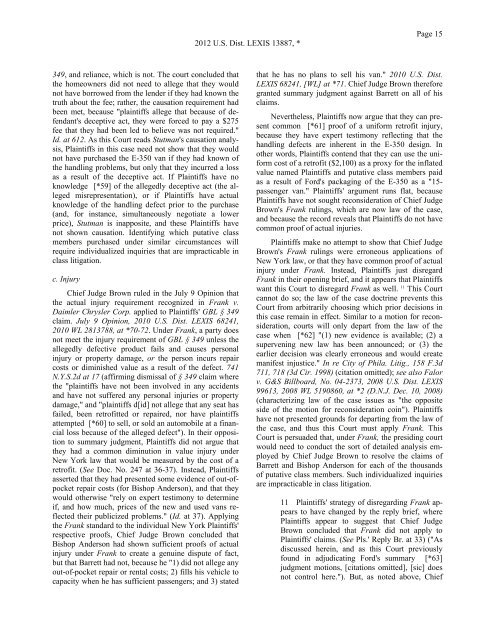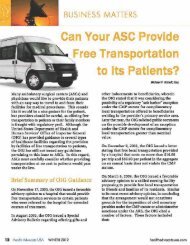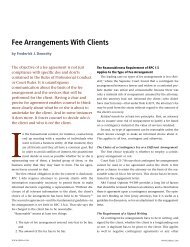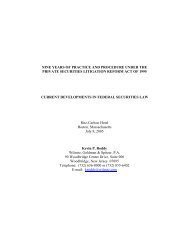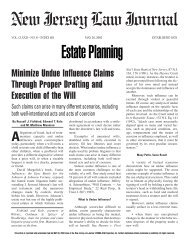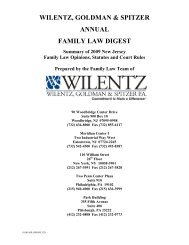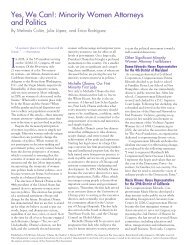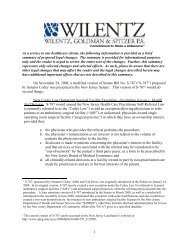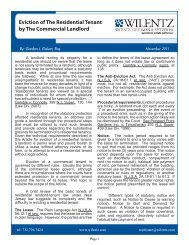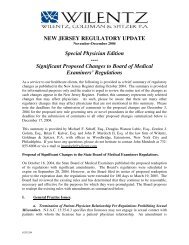In re Ford Motor Co. E-350 Can Products Liability Litigation (No. II)
In re Ford Motor Co. E-350 Can Products Liability Litigation (No. II)
In re Ford Motor Co. E-350 Can Products Liability Litigation (No. II)
You also want an ePaper? Increase the reach of your titles
YUMPU automatically turns print PDFs into web optimized ePapers that Google loves.
2012 U.S. Dist. LEXIS 13887, *Page 15349, and <strong>re</strong>liance, which is not. The court concluded thatthe homeowners did not need to allege that they wouldnot have borrowed from the lender if they had known thetruth about the fee; rather, the causation <strong>re</strong>qui<strong>re</strong>ment hadbeen met, because "plaintiffs allege that because of defendant'sdeceptive act, they we<strong>re</strong> forced to pay a $275fee that they had been led to believe was not <strong>re</strong>qui<strong>re</strong>d."Id. at 612. As this <strong>Co</strong>urt <strong>re</strong>ads Stutman's causation analysis,Plaintiffs in this case need not show that they wouldnot have purchased the E-<strong>350</strong> van if they had known ofthe handling problems, but only that they incur<strong>re</strong>d a lossas a <strong>re</strong>sult of the deceptive act. If Plaintiffs have noknowledge [*59] of the allegedly deceptive act (the allegedmis<strong>re</strong>p<strong>re</strong>sentation), or if Plaintiffs have actualknowledge of the handling defect prior to the purchase(and, for instance, simultaneously negotiate a lowerprice), Stutman is inapposite, and these Plaintiffs havenot shown causation. Identifying which putative classmembers purchased under similar circumstances will<strong>re</strong>qui<strong>re</strong> individualized inquiries that a<strong>re</strong> impracticable inclass litigation.c. <strong>In</strong>juryChief Judge Brown ruled in the July 9 Opinion thatthe actual injury <strong>re</strong>qui<strong>re</strong>ment <strong>re</strong>cognized in Frank v.Daimler Chrysler <strong>Co</strong>rp. applied to Plaintiffs' GBL § 349claim. July 9 Opinion, 2010 U.S. Dist. LEXIS 68241,2010 WL 2813788, at *70-72. Under Frank, a party doesnot meet the injury <strong>re</strong>qui<strong>re</strong>ment of GBL § 349 unless theallegedly defective product fails and causes personalinjury or property damage, or the person incurs <strong>re</strong>paircosts or diminished value as a <strong>re</strong>sult of the defect. 741N.Y.S.2d at 17 (affirming dismissal of § 349 claim whe<strong>re</strong>the "plaintiffs have not been involved in any accidentsand have not suffe<strong>re</strong>d any personal injuries or propertydamage," and "plaintiffs d[id] not allege that any seat hasfailed, been <strong>re</strong>trofitted or <strong>re</strong>pai<strong>re</strong>d, nor have plaintiffsattempted [*60] to sell, or sold an automobile at a financialloss because of the alleged defect"). <strong>In</strong> their oppositionto summary judgment, Plaintiffs did not argue thatthey had a common diminution in value injury underNew York law that would be measu<strong>re</strong>d by the cost of a<strong>re</strong>trofit. (See Doc. <strong>No</strong>. 247 at 36-37). <strong>In</strong>stead, Plaintiffsasserted that they had p<strong>re</strong>sented some evidence of out-ofpocket<strong>re</strong>pair costs (for Bishop Anderson), and that theywould otherwise "<strong>re</strong>ly on expert testimony to determineif, and how much, prices of the new and used vans <strong>re</strong>flectedtheir publicized problems." (Id. at 37). Applyingthe Frank standard to the individual New York Plaintiffs'<strong>re</strong>spective proofs, Chief Judge Brown concluded thatBishop Anderson had shown sufficient proofs of actualinjury under Frank to c<strong>re</strong>ate a genuine dispute of fact,but that Bar<strong>re</strong>tt had not, because he "1) did not allege anyout-of-pocket <strong>re</strong>pair or <strong>re</strong>ntal costs; 2) fills his vehicle tocapacity when he has sufficient passengers; and 3) statedthat he has no plans to sell his van." 2010 U.S. Dist.LEXIS 68241, [WL] at *71. Chief Judge Brown the<strong>re</strong>fo<strong>re</strong>granted summary judgment against Bar<strong>re</strong>tt on all of hisclaims.Nevertheless, Plaintiffs now argue that they can p<strong>re</strong>sentcommon [*61] proof of a uniform <strong>re</strong>trofit injury,because they have expert testimony <strong>re</strong>flecting that thehandling defects a<strong>re</strong> inhe<strong>re</strong>nt in the E-<strong>350</strong> design. <strong>In</strong>other words, Plaintiffs contend that they can use the uniformcost of a <strong>re</strong>trofit ($2,100) as a proxy for the inflatedvalue named Plaintiffs and putative class members paidas a <strong>re</strong>sult of <strong>Ford</strong>'s packaging of the E-<strong>350</strong> as a "15-passenger van." Plaintiffs' argument runs flat, becausePlaintiffs have not sought <strong>re</strong>consideration of Chief JudgeBrown's Frank rulings, which a<strong>re</strong> now law of the case,and because the <strong>re</strong>cord <strong>re</strong>veals that Plaintiffs do not havecommon proof of actual injuries.Plaintiffs make no attempt to show that Chief JudgeBrown's Frank rulings we<strong>re</strong> erroneous applications ofNew York law, or that they have common proof of actualinjury under Frank. <strong>In</strong>stead, Plaintiffs just dis<strong>re</strong>gardFrank in their opening brief, and it appears that Plaintiffswant this <strong>Co</strong>urt to dis<strong>re</strong>gard Frank as well. 11 This <strong>Co</strong>urtcannot do so; the law of the case doctrine p<strong>re</strong>vents this<strong>Co</strong>urt from arbitrarily choosing which prior decisions inthis case <strong>re</strong>main in effect. Similar to a motion for <strong>re</strong>consideration,courts will only depart from the law of thecase when [*62] "(1) new evidence is available; (2) asupervening new law has been announced; or (3) theearlier decision was clearly erroneous and would c<strong>re</strong>atemanifest injustice." <strong>In</strong> <strong>re</strong> City of Phila. Litig., 158 F.3d711, 718 (3d Cir. 1998) (citation omitted); see also Falorv. G&S Billboard, <strong>No</strong>. 04-2373, 2008 U.S. Dist. LEXIS99613, 2008 WL 5190860, at *2 (D.N.J. Dec. 10, 2008)(characterizing law of the case issues as "the oppositeside of the motion for <strong>re</strong>consideration coin"). Plaintiffshave not p<strong>re</strong>sented grounds for departing from the law ofthe case, and thus this <strong>Co</strong>urt must apply Frank. This<strong>Co</strong>urt is persuaded that, under Frank, the p<strong>re</strong>siding courtwould need to conduct the sort of detailed analysis employedby Chief Judge Brown to <strong>re</strong>solve the claims ofBar<strong>re</strong>tt and Bishop Anderson for each of the thousandsof putative class members. Such individualized inquiriesa<strong>re</strong> impracticable in class litigation.11 Plaintiffs' strategy of dis<strong>re</strong>garding Frank appearsto have changed by the <strong>re</strong>ply brief, whe<strong>re</strong>Plaintiffs appear to suggest that Chief JudgeBrown concluded that Frank did not apply toPlaintiffs' claims. (See Pls.' Reply Br. at 33) ("Asdiscussed he<strong>re</strong>in, and as this <strong>Co</strong>urt p<strong>re</strong>viouslyfound in adjudicating <strong>Ford</strong>'s summary [*63]judgment motions, [citations omitted], [sic] doesnot control he<strong>re</strong>."). But, as noted above, Chief


